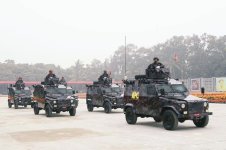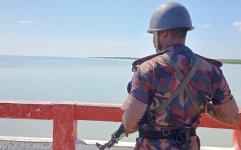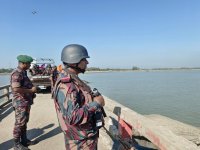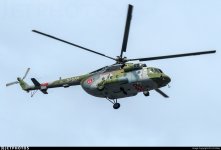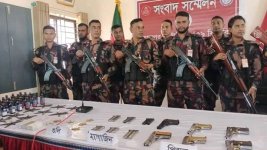Arthur
Senior Member
- Dec 16, 2014
- 2,058
- 3,867
- Country of Origin

- Country of Residence

A lot is talked about Army,navy and air force.But these are the men who will first face the enemy.
BANGLADESH RIFLES(BDR)
"The Vigilant Sentinels of Our National Frontier"
Bangladesh Rifles (BDR) is a paramilitary force in Bangladesh. Mainly associated with guarding the borders of the country, this force is known by the Bangladeshi as "The Vigilant Sentinels of Our National Frontier"[1]. The British had first organized the Ramgarh Local Battalion in 1795 by recruiting the native population. The battalion was succeeded by the Eastern Frontier Rifles, which guarded the frontier from 1891 to 1920, when it was disbanded. Border duties were assumed by the East Pakistan Rifles & finally by the BDR.
Apart from its primary task of protecting the borders, the members of Bangladesh Rifles have taken part in other military operations. This force was vested with the additional task of checking smuggling in 1958. Its members took up arms in an organized manner against the Pakistan Army during the liberation war of 1971. Several members earned gallantry awards - for example, Lance Naik Nur Mohammad Sheikh and Lance Naik Munshi Abdur Rouf earned the highest gallantry award, the Bir Sreshtha; 8 others were awarded the Bir Uttam, 40 other the, Bir Bikram and 91 the Bir Patik.
The BDR is headed by a Director General. Its total manpower is 67,000, organized into a central headquarters and various sectors, battalions and border outposts, mainly along the frontiers.
Infantry Weapons
Crew-served weapons in service with the Bangladesh Army, and Paramilitary Forces include mortars, recoilless rifles and rockets, anti-tank guided missiles, and machine guns. They are deployed in the fire support attachments to the infantry regiment, battalion, and company. Heavy weapons for regiment uses are mostly vehicle-mounted or -towed. Medium and light weapons are carried by hand into firing positions. Some weapons in service with the Bangladesh Army, and Paramilitary Forces include:
Light weapons used by the Bangladeshi Land Forces (Army, Special Operations Forces, Bangladesh Rifles, Ansar, VDP, Rapid Action Battalion, Armed Police Battalion and Police Force) include HP-35, P226, P228, Sterling submachine gun, MP-5, UZI, Type 56 assault rifle (Chinese copy of the AK-47), AKM, AK-103, M-4 Carbine, SKS (Type 56/63), FN-FAL, H&K G3, Heckler & Koch MSG-90, G3SG/1, HK11A1, HK 21A1, MG3, DShK,Grenade Launchers, Carl Gustav M-2/M-3, M-40 recoilless rifle, Type 65 RCL, LAW, RPG-7, Type 81 Assault rifles ; and the standard issue - G3A3 Battle rifle.
Logistical Vehicles
Types of vehicles are active in this role commonly light off-road vehicles, utility 4x4's, tank transporters, troop carriers, water trucks, fuel tankers, and other trucks categorized into 0.5-ton, 3.5-ton, 5-ton, 7-ton, and 12-ton class according to their load capabilities, while the special purpose vehicles are mainly used as chassis for various weapon systems and equipments.
Imported vehicles usually come from various countries including Turkey, Japan, China and occasionally from India & Pakistan.Currently it has bought a large number of Armored Personnel Carriers (APCs) from Turkey in order to deploy troops in the front line during the battle.
The list of Battles and wars BDR participated are as follows:
* First Anglo-Burmese War (1824-1826) - as Ramgarh Local Rifles
* Second Anglo-Burmese War (1852-1853) - as Ramgarh Local Rifles
* Third Anglo-Burmese War (1885-1886) - as Frontier Guards-
* Anglo-Kuki or Anglo-Manipur War (1891) - as Bengal Military Police
* Second World War - Burma Campaign (1943-44) - as Eastern Frontier Rifles
* First Indo-Pak War (1948) - as East Pakistan Rifles
* Second Indo-Pak War (1965) - as E.P.R.
* Bangladesh Liberation War (1971) - as Bangladesh Rifles
* Chittagong Hill Tracts Counter-Insurgency War (1976-1997) - as BDR
* 2001 Indian-Bangladeshi border conflict - as Bangaldesh Rifles (BDR)
was posted in old forum by @LeonBlack08
BANGLADESH RIFLES(BDR)
"The Vigilant Sentinels of Our National Frontier"
Bangladesh Rifles (BDR) is a paramilitary force in Bangladesh. Mainly associated with guarding the borders of the country, this force is known by the Bangladeshi as "The Vigilant Sentinels of Our National Frontier"[1]. The British had first organized the Ramgarh Local Battalion in 1795 by recruiting the native population. The battalion was succeeded by the Eastern Frontier Rifles, which guarded the frontier from 1891 to 1920, when it was disbanded. Border duties were assumed by the East Pakistan Rifles & finally by the BDR.
Apart from its primary task of protecting the borders, the members of Bangladesh Rifles have taken part in other military operations. This force was vested with the additional task of checking smuggling in 1958. Its members took up arms in an organized manner against the Pakistan Army during the liberation war of 1971. Several members earned gallantry awards - for example, Lance Naik Nur Mohammad Sheikh and Lance Naik Munshi Abdur Rouf earned the highest gallantry award, the Bir Sreshtha; 8 others were awarded the Bir Uttam, 40 other the, Bir Bikram and 91 the Bir Patik.
The BDR is headed by a Director General. Its total manpower is 67,000, organized into a central headquarters and various sectors, battalions and border outposts, mainly along the frontiers.
Infantry Weapons
Crew-served weapons in service with the Bangladesh Army, and Paramilitary Forces include mortars, recoilless rifles and rockets, anti-tank guided missiles, and machine guns. They are deployed in the fire support attachments to the infantry regiment, battalion, and company. Heavy weapons for regiment uses are mostly vehicle-mounted or -towed. Medium and light weapons are carried by hand into firing positions. Some weapons in service with the Bangladesh Army, and Paramilitary Forces include:
Light weapons used by the Bangladeshi Land Forces (Army, Special Operations Forces, Bangladesh Rifles, Ansar, VDP, Rapid Action Battalion, Armed Police Battalion and Police Force) include HP-35, P226, P228, Sterling submachine gun, MP-5, UZI, Type 56 assault rifle (Chinese copy of the AK-47), AKM, AK-103, M-4 Carbine, SKS (Type 56/63), FN-FAL, H&K G3, Heckler & Koch MSG-90, G3SG/1, HK11A1, HK 21A1, MG3, DShK,Grenade Launchers, Carl Gustav M-2/M-3, M-40 recoilless rifle, Type 65 RCL, LAW, RPG-7, Type 81 Assault rifles ; and the standard issue - G3A3 Battle rifle.
Logistical Vehicles
Types of vehicles are active in this role commonly light off-road vehicles, utility 4x4's, tank transporters, troop carriers, water trucks, fuel tankers, and other trucks categorized into 0.5-ton, 3.5-ton, 5-ton, 7-ton, and 12-ton class according to their load capabilities, while the special purpose vehicles are mainly used as chassis for various weapon systems and equipments.
Imported vehicles usually come from various countries including Turkey, Japan, China and occasionally from India & Pakistan.Currently it has bought a large number of Armored Personnel Carriers (APCs) from Turkey in order to deploy troops in the front line during the battle.
The list of Battles and wars BDR participated are as follows:
* First Anglo-Burmese War (1824-1826) - as Ramgarh Local Rifles
* Second Anglo-Burmese War (1852-1853) - as Ramgarh Local Rifles
* Third Anglo-Burmese War (1885-1886) - as Frontier Guards-
* Anglo-Kuki or Anglo-Manipur War (1891) - as Bengal Military Police
* Second World War - Burma Campaign (1943-44) - as Eastern Frontier Rifles
* First Indo-Pak War (1948) - as East Pakistan Rifles
* Second Indo-Pak War (1965) - as E.P.R.
* Bangladesh Liberation War (1971) - as Bangladesh Rifles
* Chittagong Hill Tracts Counter-Insurgency War (1976-1997) - as BDR
* 2001 Indian-Bangladeshi border conflict - as Bangaldesh Rifles (BDR)
was posted in old forum by @LeonBlack08


